Fincantieri Expects Profitability in 2021 with Strong Order Backlog

Citing the strength of the company’s order book and success at returning to full production levels during the fourth quarter, Fincantieri’s CEO Giuseppe Bono forecast a strong return for the business in 2021 including profitability and improved operations. Due to the strains placed on the shipbuilder’s global operations due to the pandemic and the cruise industry which is its largest customer, the company reported declines in revenues and operating income before interest taxes and a net loss after expenses related to COVID-19 and asbestos-related litigation.
“Throughout 2020, the pandemic put a severe strain on the global economy, painfully impacting all industries and especially large-scale enterprises, said Bono during the company’s board meeting. “In such a scenario, we have proven our prompt responsiveness, by rescheduling our production programs and adjusting our operational processes accordingly. Fourth quarter results show further progresses with respect to those already made in the previous quarter... As long as scientific progress is made in treatments and vaccines, we expect a growth of 25 percent, led by our considerable backlog, as well as improving marginality and return to profit.”
New orders for 2020 came in at half the level of 2019, but Fincantieri recorded 18 new contracts. Bono highlighted a backlog of 116 vessels on order at the end of 2020 valued at €35.7 billion ($43.1 billion) of which three-quarters are firm orders for 97 vessels to be delivered up to 2029. The company also continues to diversify its work, with Bono citing the delivery of the new Genoa bridge in 2020 and efforts to expand the scope of work at VARD into sectors including renewable energy and unmanned vessels. They are also developing a green ammonia fuel system.
To preserve the sizable backlog, as well as strengthen the relationship with its clients, Fincantieri employed a strategy of granting deferments to customers.
Despite a 20 percent decline in production hours related to the measures enacted in response to the pandemic and Italy’s extended lockdown in the spring, the company reported revenues of €5.2 billion ($6.3 billion) for the year which was down 11 percent from 2019. EBITDA remained largely steady with less than a two percent decline but the net loss ballooned to €245 million ($295 million) up nearly €100 million ($120 million) versus 2019. Net debt also grew to more than €1 billion ($1.2 billion).
A total of 19 projects were delivered from 11 shipyards during 2020. This included a total of seven cruise ships, four of which were delivered in the second half of 2020. They also delivered two expedition cruise ships and four naval ships.
While the cruise ship industry was largely at a standstill, Fincantieri still confirmed orders from Norwegian Cruise Line Holdings as well as maintaining its entire current order book for the cruise industry. The naval operations units won orders including two frigates and two submarines from Italy as well as getting its Narvis joint venture fully operational. In the U.S., Fincantieri Marinette Marine prevailed over other leading shipbuilders to be awarded the contract for the first-in-class unit of the new guided missile frigate for the U.S. Navy.
The outlook for Fincantieri's shipbuilding business in 2021 foresees production volumes that are expected to be significantly higher than in 2020. A total of five cruise ships are scheduled to be delivered from the yards in Italy as well as two expedition cruise ships from VARD. They are also planning greater integration of all the shipyards in Italy and Romania working on cruise ships as well as capital investments at the yards in Marghera and Monfalcone. Five naval vessels are scheduled to be delivered by the Italian yards and three from the U.S. shipyards.
The group expects to overall return to the pre-COVID-19 growth levels in 2021 through the development of the current sizable backlog. Barring relapses in the pandemic, they forecast revenues to increase by 25 to 30 percent, when compared to 2020. The group is expected to return to its growth guidelines outlined before the pandemic and forecast it might even return to sustainable dividends distribution starting as soon as 2022.
